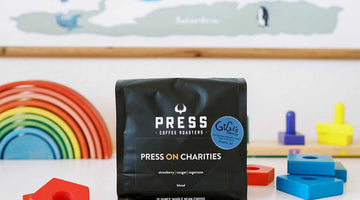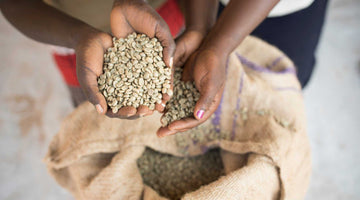Organic ceremonial-grade matcha provides a rich, complex taste and a boost of calm energy for the day. This matcha from Art of Tea is produced from fresh, stone-ground leaves and made into a creamy, smooth drink that’s delicious any time of day!
Enjoy matcha hot or cold at your favorite PRESS location!

What is Matcha?
Matcha is finely ground powder of specially grown and processed green tea leaves, traditionally consumed in East Asia. The green tea plants used for matcha are shade-grown for three to four weeks before harvest; the stems and veins are removed during processing. During shaded growth, the plant Camellia sinensis produces more theanine and caffeine. The powdered form of matcha is consumed differently from tea leaves or tea bags, as it is suspended in a liquid, typically water or milk.
Art of Tea's ceremonial grade matcha is one of the best in the world. It is a blend of three varietals and has notes of honeydew melon, lemon, and tastes very clean. We tested more than 25 of the best matcha offerings and selected this one for its unmatched quality and flavor.
History of Matcha:
Contrary to the popular belief that matcha derives from Japan, it originally emerged during the Song Dynasty in China. Matcha is made from a shade-grown green tea, also known as Gyokuro that is carefully steamed and meticulously dried. After the steaming process, the leaves are separated from the stems and the leaves alone, called tencha, are grounded into a powder called matcha. The art of producing, preparing, and consuming this powdered tea became a ritual performed by Zen Buddhists in China. In 1191, a Zen monk by the name of Eisai, traveled to Japan and introduced matcha to the country. As matcha’s popularity lessened in China, the Japanese embraced this powdered tea. Matcha eventually became an important part of rituals in Zen monasteries in Japan.
Why Is Matcha So Healthy?
The reason matcha stands out in its health benefits is that unlike regular brewed tea, drinking matcha involves consuming the entirety of the tea leaf. While brewing regular green tea involves only ingesting the phytonutrients and chemicals that can seep out of the tea leaf into the water, powdered matcha contains every part of the tea leaf – and consuming matcha powdered tea means ingesting every chemical present in the tea leaf.
Because of its unique composition, matcha boasts more antioxidants than almost any other food or drink. In fact, drinking a single cup of matcha tea provides the same amount of antioxidants as 10 cups of green tea – making it a powerful drink for health effects.
How Matcha Promotes Health
There's a wide base of research linking matcha to a number of positive health benefits. While these effects have not been conclusively proven, research suggests matcha may confer the following benefits:
- Cancer-Fighting Properties
- Anti-Aging Effects
- Weight Loss
- A Calm Energy Boost without Jitters
- Detoxifies the Body Thanks to Increased Chlorophyll Content
- Boosts Metabolism
- Rich in Vitamins & Vital Minerals
- Enhances Mood & Cognitive Function
Just like there are fine wines, there are fine matchas. It's easy to tell the highest grade (Ceremonial Grade) from the next lower grade (Grade A) because the grade is often written on the label. But other than the labeling, what is it you should be looking for in good matcha?

Color
Matcha in both the powdered and prepared forms has a beautiful color. When powdered, it's a vibrant, bright green. When prepared, it darkens into a magnificent emerald hue. There are a few reasons why Matcha has this amazing color. First, tencha (the leaf eventually ground into matcha) is usually shade-grown, which helps lock in chlorophyll. This chlorophyll gives the leaf a deep green color. The other is that matcha is the powder of an entire leaf. While many green teas are just the extraction of oils from leaves, matcha is the tea leaf itself. That means you're getting the concentrated color of the leaf, too.
Great matcha will have this signature, bright green color. Lesser matchas won't be this amazing shade. They'll still be green, but the color itself will include more yellow or brown. This discoloration comes from the oxidization of the matcha. You'll even notice high-quality matchas picking up these colors if you don't store your tea properly. Exposure to light, heat, and air can taint matcha's amazing color. Therefore, fresher, high-quality matchas that have been handled properly and swiftly will have a more vibrant green color.
Flavor and Scent
Even though all tea comes from the same plant, the flavor can vary wildly. Black tea tastes nothing like Japanese green tea. And Silver Needle tastes very dissimilar to a highly-oxidized oolong. Matchas can have slightly varying flavors, too. All matchas will have a grassy, sweet, umami flavor, as that is the nature of Japanese green teas, but some will be sweeter or grassier than others. Great matchas will also have a velvety-soft mouthfeel in common. Though this texture will vary from matcha to matcha, too.
If your matcha is overwhelmingly bitter or has an off scent, it's likely not the best quality. While matcha can have subtle bitterness, like a non-powdered tea, matcha should not be astringent. We've also heard of bad matchas smelling fishy. While matcha can sometimes have umami, grassy scent, it should never smell "fishy." In fact, we've never encountered matcha with that scent.





